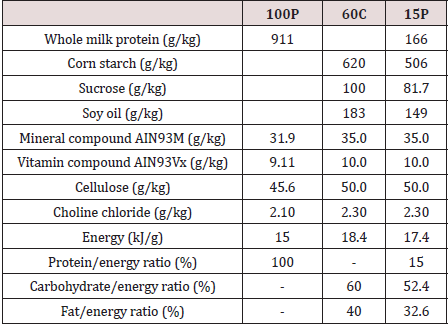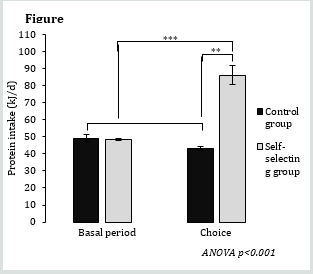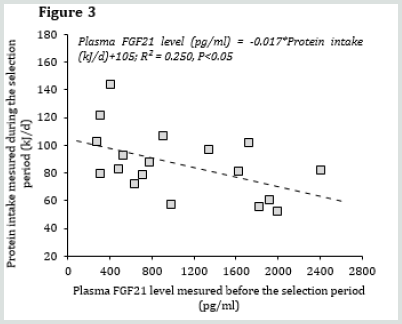
Lupine Publishers Group
Lupine Publishers
Menu
ISSN: 2638-5910
Short Communication(ISSN: 2638-5910) 
Variability in Plasma FGF21 Levels in Rats Fed A Standard 15% Protein Diet is not Sensitive Enough to Reflect Differences in Protein Requirements Volume 3 - Issue 1
Joséphine Gehring* , Dalila Azzout-Marniche and Patrick C Even
- Université Paris-Saclay, AgroParisTech, INRAE. UMR PNCA, 75005, Paris, France
Received: October 19, 2020 Published: October 27, 2020
Corresponding author: Joséphine Gehring, Université Paris-Saclay, AgroParisTech, INRAE, UMR PNCA, 75005, Paris, France
DOI: 10.32474/ADO.2020.03.000154
Keywords: Inter-Individual Variability; Plasma FGF21 Level; Protein Level; Self-Selection Diet
Abbreviations: FGF21: Fibroblast Growth Factor 21; SEM: Standard Error of the Mean
Introduction
Fibroblast growth factor 21 (FGF21) is a hepatokine member of
a subfamily of “fibroblast growth factors” that responds to multiple
metabolic stresses as protein deficiency [1-4]. FGF21 is produced
in various tissues but the FGF21 circulating form is primarily
of hepatic origin [1,2]. FGF21 affects numerous metabolic and
behavioural parameters, and in particular, increases appetite for
protein in subjects fed a protein-deprived diets [5,6]. In a recent
still unpublished study, we observed that plasma FGF21 levels were
higher in adult male Wistar rats fed a standard diet, formulated
according the AIN93 recommendations for rats’ feed, containing
15% protein by energy [7] than in rats fed a 30% protein diet. In
addition, inter-individual variability of plasma FGF21 levels was
larger in rats fed the standard 15% protein diet than in rats fed
the 30% protein diet. We therefore considered the hypothesis
that higher levels and inter-individual variability in plasma FGF21
levels in rats fed a standard 15% protein diet would reflect the
variability in protein requirements between individuals and thus,
that measurement of plasma FGF21 levels can be used as a simple,
rapid, and minimally-invasive test to estimate the adequacy of
protein intake.
Dietary self-selection is a method that has been largely used
in farm animals and laboratory rodents to study the requirements
for macronutrients (carbohydrates, lipids and proteins), vitamins
and minerals [8,9]. Many studies using this method, in our lab and
others, showed that rats self-selecting between a protein diet and
a protein-free diet often ingest up to 30-50% of total energy intake
as protein [10-15], so much higher than the level considered as
sufficient for an optimal growth in adult rats (10-15% by energy),
which comforted our hypothesis that 15% dietary protein was
possibly not the optimal dietary content.
The objective of this study was to verify that variability in
plasma FGF21 levels in rats fed a standard 15% protein diet was
indicative of differences in protein requirements. To this end, we
have analyzed the relationship between FGF21 levels, and the level
of protein subsequently selected during self-selection between a
protein diet and a protein-free diet.
Experimental Procedure
24 adult male rats (215-240g) of the Wistar RccHan strain (ENVIGO) were used and individually housed (22°C ± 1°C, 12/12 L/D, cycle lights on at 08:00). After 1 week of adaptation to the laboratory conditions, the rats were fed for 12 days (Basal period) a standard diet formulated according to the AIN93 requirements [7] that contained 15% protein (15P); then, for 28 days (Choice period), 6 rats (Control group) continued to be fed with the standard diet and 18 (Self-selecting group) were given a choice between a pure protein diet (100P) and a protein-free diet containing a mix of fat (soy oil) and carbohydrate (corn starch and sucrose) in which carbohydrate amounted 60% by energy. The diets were provided, as necessary.
The food pellets were prepared twice a week by mixing the macronutrients, vitamins, and mineral mix with the amount of water required to make a thick dough. Food intake (g/day) was measured twice a week and converted in kJ/day based on the energy content of the diets (Table 1).
Table 1: Composition and energy content of the 3 used diets.

100P: diet containing only proteins; 60C: protein-free diet containing only lipids and carbohydrates and in which carbohydrates amounted 60% by energy; 15P: standard diet containing 15% of protein by energy.
Blood samples (0.5 mL) were collected from the tail vein in EDTA tubes: once during the basal period and once during the choice period. Blood collection was made in the morning (10:00- 12:00) in rats that were not previously fasted. Blood samples were centrifuged (5000g, 15min, 4°C) and the plasma stored at -20°C. Plasma FGF21 levels (pg/ml) were measured by ELISA tests using commercial kits from Bio Vendor (Mouse/Rat FGF-21 ELISA RD291108200R).
Statistical Analysis
Statistical tests were performed using RStudio software, 2015. Changes in protein intake and plasma FGF21 level were compared using mixed two-factor ANOVA tests (parameter ~ group*period), which were followed by the main effects analysis by Bonferroni adjusted pairwise comparisons. Values are presented as means ± standard error of the mean (SEM). Linear regression analysis was used to study the link between plasma FGF21 levels during the basal period and protein intake during the choice period and was performed using Excel software. Significance of correlations was assessed using the Pearson correlation coefficient. A threshold of P≤0.05 was chosen as significant.
Results and Discussion
Protein intake was similar between the control and selfselecting group during the basal period but increased by 80% in the self-selecting group during the choice period (+37.8 kJ/d, p<0.0001) (Figure 1). This response significantly increased the contribution of protein to total energy intake from 15.0% to 23.5% (p<0.001). Mean plasma FGF21 levels averaged ~1,100 pg/mL in both groups during the basal period and decreased to 131 pg/mL in self-selecting group during the choice period (P<0.001) (Figure 2). Finally, contrary to our hypothesis, not only did we not observe a positive correlation between plasma FGF21 levels during the basal period and protein intake during the choice period, but instead we observed a weak and inverse correlation (Figure 3).
Figure 1: Protein intake (kJ/d) according to diet group and period.
(*:0.05; **:0.01; ***:0.001; ****:0.0001) Values are represented as means ±SEM, only the p-value of the interaction of ANOVA tests
are indicated.

Figure 2: FGF21 level in plasma (pg/ml) according to diet group and period.
(*:0.05; **:0.01; ***:0.001; ****:0.0001) Values are represented as means ±SEM, only the p-value of the interaction of ANOVA tests
are indicated.

Figure 3: Protein intake (kJ/d) during the choice period as a function of plasma FGF21 levels during the basal period in the self-selecting group.

Conclusion
In conclusion, inter-individual variability in plasma FGF21 levels in rats fed a standard 15% protein diet did not appear to be a parameter sensitive enough to reflect inter-individual differences in protein requirements. Therefore, plasma FGF21 level cannot be used as a test to determine inter-individual variability in protein requirements in individuals. Nevertheless we observed that plasma FGF21 levels in P15 fed rats were ~7 fold higher than in selfselecting rats ingesting 23.5% protein, which points on the fact that changes in plasma FGF21 levels are very sensitive to dietary protein intake, even when protein intake is well above essential protein requirements (~8-10 % in adult male rats).
Acknowledgments
The authors thank Morgane Dufay for her precious help in the maintenance of the rats during the study.
References
- Staiger H, Keuper M, Berti L, Hrabě de Angelis M, Häring HU (2017) Fibroblast Growth Factor 21-Metabolic Role in Mice and Men. Endocr Rev 38(5): 468-488.
- Kathleen R Markan, Meghan C Naber, Magdalene K Ameka, Maxwell D Anderegg, David J Mangelsdorf, et al. (2014) Circulating FGF21 Is Liver Derived and Enhances Glucose Uptake During Refeeding and Overfeeding. Diabetes 63(12): 4057-4063.
- Catherine Chaumontet, Dalila Azzout-Marniche, Anne Blais, Julien Piedcoq, Daniel Tomé, et al. (2019) Low-protein and methionine, high-starch diets increase energy intake and expenditure, increase FGF21, decrease IGF-1, and have little effect on adiposity in mice. Am J Physiol-Regul Integr Comp Physiol 316(5): R486-R501.
- Fisher FM, Maratos-Flier E (2016) Understanding the Physiology of FGF21. Annu Rev Physiol 78(1): 223-241.
- Tomé D, Chaumontet C, Even PC, Darcel N, Azzout-Marniche D (2019) Protein status modulates the rewarding value of foods and meals to maintain an adequate protein intake. Physiol Behav 206: 7-12.
- Tomé D, Chaumontet C, Even PC, Darcel N, Thornton SN, et al. (2020) Protein Status Modulates an Appetite for Protein to Maintain a Balanced Nutritional State-A Perspective View. J Agric Food Chem 68(7): 1830-1836.
- Reeves PG, Nielsen FH, Fahey GC (1993) AIN-93 purified diets for laboratory rodents: final report of the American Institute of Nutrition ad hoc writing committee on the reformulation of the AIN-76A rodent diet. J Nutr 123(11): 1939-1951.
- Richter CP, Holt Jr LE, Barelare Jr B (1938) Nutritional requirements for normal growth and reproduction in rats studied by the self-selection method. American Journal of Physiology 122: 734-744.
- George Collier Alan I, Leshner, Robert L Squibb (1969) Dietary self-selection in active and non-active rats. Physiol Behav 4(1): 79-82.
- Musten B, Peace D, Anderson GH (1974) Food intake regulation in the weanling rat: self-selection of protein and energy. J Nutr 104(5): 563-572.
- Castonguay TW, Hartman WJ, Fitzpatrick EA, Stern JS (1982) Dietary self-selection and the Zucker rat. J Nutr 112(4): 796-800.
- Mullen BJ, Martin RJ (1992) Novel approach to diet design for determining macronutrient preference. Pharmacol Biochem Behav 42(2): 343-346.
- Jean C, Fromentin G, Tomé D, Larue-Achagiotis C (2002) Wistar rats allowed to self-select macronutrients from weaning to maturity choose a high-protein, high-lipid diet. Physiol Behav 76(1): 65-73.
- Makarios-Lahham L, Roseau SM, Fromentin G, Tome D, Even PC (2004) Rats free to select between pure protein and a fat-carbohydrate mix ingest high-protein mixed meals during the dark period and protein meals during the light period. J Nutr 134(3): 618-624.
- Azzout-Marniche D, Chalvon-Demersay T, Pimentel G, Catherine Chaumontet, Nachiket A Nadkarni, et al. (2016) Obesity-prone high-fat-fed rats reduce caloric intake and adiposity and gain more fat-free mass when allowed to self-select protein from carbohydrate:fat intake. Am J Physiol-Regul Integr Comp Physiol 310(11): R1169-R1176.

Top Editors
-

Mark E Smith
Bio chemistry
University of Texas Medical Branch, USA -

Lawrence A Presley
Department of Criminal Justice
Liberty University, USA -

Thomas W Miller
Department of Psychiatry
University of Kentucky, USA -

Gjumrakch Aliev
Department of Medicine
Gally International Biomedical Research & Consulting LLC, USA -

Christopher Bryant
Department of Urbanisation and Agricultural
Montreal university, USA -

Robert William Frare
Oral & Maxillofacial Pathology
New York University, USA -

Rudolph Modesto Navari
Gastroenterology and Hepatology
University of Alabama, UK -

Andrew Hague
Department of Medicine
Universities of Bradford, UK -

George Gregory Buttigieg
Maltese College of Obstetrics and Gynaecology, Europe -

Chen-Hsiung Yeh
Oncology
Circulogene Theranostics, England -
.png)
Emilio Bucio-Carrillo
Radiation Chemistry
National University of Mexico, USA -
.jpg)
Casey J Grenier
Analytical Chemistry
Wentworth Institute of Technology, USA -
Hany Atalah
Minimally Invasive Surgery
Mercer University school of Medicine, USA -

Abu-Hussein Muhamad
Pediatric Dentistry
University of Athens , Greece

The annual scholar awards from Lupine Publishers honor a selected number Read More...




